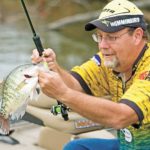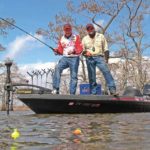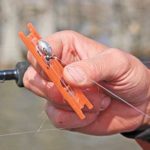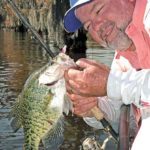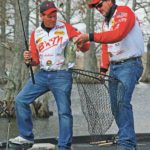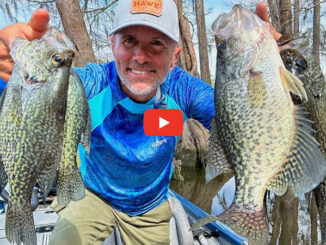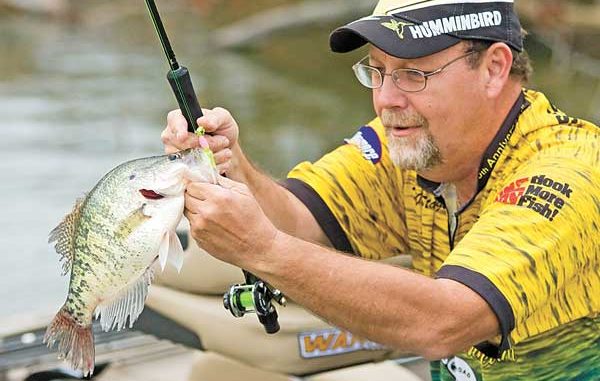
Give these techniques a try, and crappie fishing may just become one of your favorite summer pastimes.
If you were to list your all-time favorite things to do on the water during a lazy Louisiana summer, where would you rank catching crappie on a cypress-tree lake? Probably not too high, huh?
I don’t know how low you would put it, but it would definitely show up below swimming, tubing and skiing on my list.
It’s not that I enjoy those activities more than crappie fishing — because I don’t. Rather, it’s that I believe I would actually get more out of those things — exercise, a tan and girls — than I would sweating under the heat of the summer sun with a jig pole in my hand. Seems like the end result of that activity would be nothing more than some sweaty underwear.
Aren’t cypress-tree lakes where anglers go to catch crappie during the spring spawn and once the water cools back off during the fall?
Crappie fishing can be great during the summer on the right kind of lake. Cypress-tree lakes just aren’t the right kind of lake in many anglers’ opinions because they aren’t deep enough.
“That’s a silly way to think,” said Minden bass pro and Northwest Louisiana guide Homer Humphreys Jr. “White perch in a cypress-tree lake don’t know any different, so they adapt to the summer based on their surroundings. And they’ve still got to eat, which means you can still catch them during the summer if you’re got a bait in the water when they turn on.”
Somebody who knows a lot about how to catch crappie when they turn on is Ronnie Capps who, along with his tournament partner Steve Coleman, has captured five national championships along with seven “Angler of the Year” titles and over $1.3 million in winnings through competitive crappie fishing.
Capps knows how to put crappie in the boat by the dozens, and he just so happens to live on one of the most celebrated cypress-tree lakes in the country — Reelfoot Lake in Tennessee. Capps’ professional advice along with Humphreys’ local advice will have you catching crappie from cypress-tree lakes with the best of them this summer.
As for the local advice, Humphreys says the crappie in Louisiana cypress-tree lakes pretty much follow the same movement patterns throughout the year. That means they make a mass migration through sloughs and drains during the spring before fanning out to spawn on the trees.
“When the spawn is over, that means they’re going to turn around and leave the shallow water the same way they came in,” said Humphreys. “That means they’re going to migrate back to the deeper sloughs through little drains and ditches. From the sloughs, they’ll hit the main creek channels.”
Once it gets hot enough to push the shad to the middle of the channels, where bass can be found schooling, crappie will move right back out there with them, and suspend in some of the same places they used during the winter. Whether they’re trying to escape really cold or really hot water, the middles of the channels provide the relief they seek and the food they want to eat.
“If it’s not hot enough to push them into the middle of the channel, which would be around 90 degrees in a lake like Bistineau,” said Humphreys, “those white perch will live on the edges of the channel — in the brushpiles right on the lip of the drop-off.”
Capps agreed with Humphreys assessment of crappie movement on cypress-tree lakes during the summer, but he added a situation that has worked wonders for him on the crappie tournament trails that hardly anybody in Louisiana is doing is fishing spider rigs — slow-trolling, it’s called — through stump flats.
“Those old stumps are the bases of cypress trees that have fallen over for whatever reason,” Capps said, “and I’m talking about stumps that you can just barely see under the water if you can see them at all. You can put eight poles out with a jig under each, and just haphazardly run in, around and over those stumps.”
If you think running around a stump field with eight jigs hanging below your boat sounds like an invitation to staying hung up rather than catching crappie, Capps says that’s the kind of mentality that keeps you from catching as many crappie as you could.
“We catch some hogs doing that all summer long all over the south,” he said. “If I’m out just fun fishing or guiding, I use the single Southern Pro jigs under each pole. But you can bet if I’m fishing for money, I’ll be using a double-minnow rig under each pole for a total of 16 minnows swimming around those stumps — slabs, man, slabs.”
Capps says the same technique would also work well over the brushpiles on the edges of the creek channels that run through Louisiana’s shallow cypress-tree lakes as long as the baits are set to a depth that kept them running just over the brush rather than right into it.
“You can get in a groove where you can tell whether you’re on a hang and not a fish,” he said. “If you do sense your bait hanging, just pick up that pole and try to flip it over the limb or whatever it’s about to hang on.
“If you’re using that new B’n’M Minnow Rig, it has a weight above the minnows that you can use to pull the hooks free if you shake it up and down a little bit as long as it’s heavier than 1/4-ounce. And if you can’t shake it loose, the hooks will straighten before you break your line.”
Even though these anglers like to fish off the cypress trees, both readily admit that completely foregoing the trees in favor of brushpiles or stumps would mean leaving some biting fish in the lake.
In Humphreys’ case, fishing trees means getting out on the deepest flats a lake has to offer, and for Capps it means looking for trees with swell bottoms big enough to cast a shadow.
“During the summer, you can catch white perch off the cypress trees on the 10-foot flats out in Bistineau,” said Humphreys. “But to say they’re actually on the tree itself wouldn’t be very true. The key is to find the cypress trees on those 10-foot flats that have little brush tops right at their bases. Of course, if you didn’t know the difference, you would think you’re catching them off the tree.”
You don’t have to fish Bistineau to find crappie on the deep cypress flats, though. According to Humphreys, some crappie will relate to brush at the bottom of the trees on the deepest flats whether they’re 6-foot, 10-foot or 12-foot. Just find the deepest flats, and look for the trees with brush around their bases.
“And you can bet those old guys have some brush sunk around those trees no matter where you fish,” Humphreys said. “Once you find some you want to fish, try either long-poling a single tube jig — that Renosky’s Keystone Minnow also works really well — or fishing a minnow under a sliding cork right over the top of the brushpile.”
Although the middle of the day is the most uncomfortable time to be out on a lake, Humphreys says that is the perfect time to catch more and bigger crappie. The bright light from the high sun pushes the crappie down deep into the shadiest part of the brush where there is a 1- to 2-degree difference in water temperature, but they’ll often feed up from deep in the shade.
In a cypress-tree lake with little deep water and no deep trees, Capps recommended seeking out the trees that create the most shade in the water. He has found crappie like to get below any kind of ring around a tree trunk under the water or those that swell out enough at the bottom to create substantial shade.
Small groups of cypress trees that are growing closely together also create enough shade to hold some crappie, and Capps pointed out that if you could find a small group of trees with some leaning trees mixed in, you could have found yourself a hotspot.
“I like to throw a Beetle Spin in any of these situations,” Capps said. “But anything you can get down and work horizontally in those shade zones will get you some fish. A real good tip is to try to get your Beetle Spin to actually work under [any extensions off the bases of the tree with shady water underneath].
Humphreys and Capps don’t let the summer heat get them down because they know they can still catch crappie — even at cypress-tree lakes. Give their tips a try at your favorite cypress-tree lake, and you’ll have to make room at the top of your list for a new on-the-water summer activity. You may do a lot of sweating, but you’ll also get a lot of hits.
